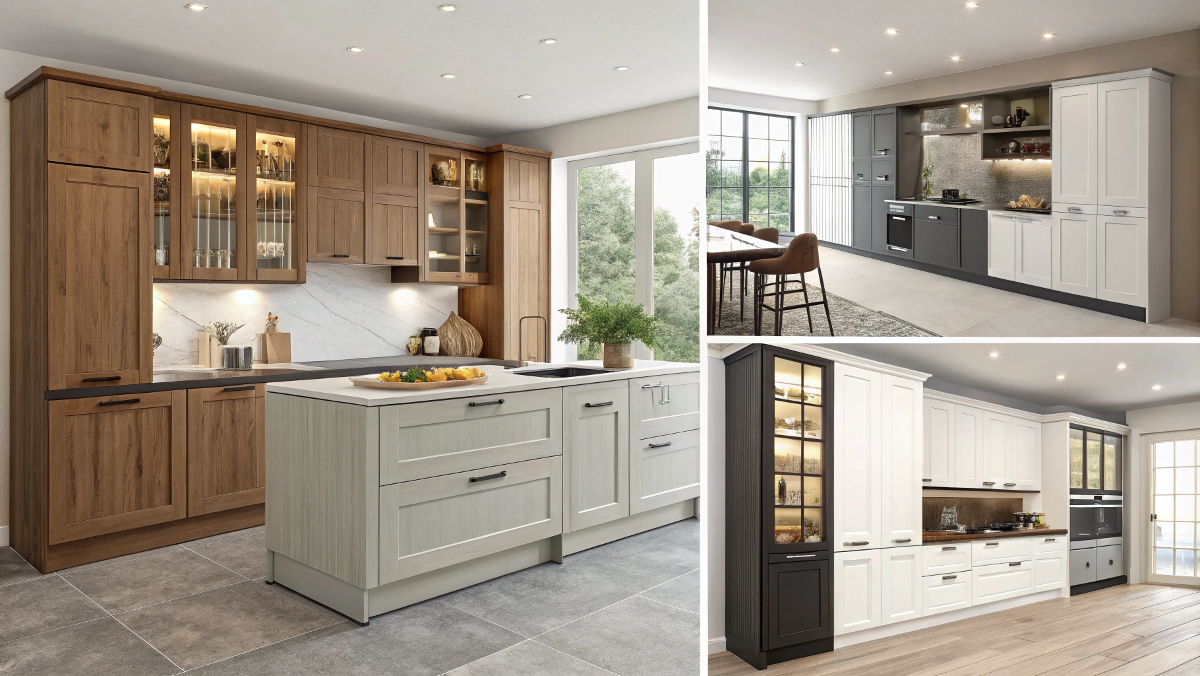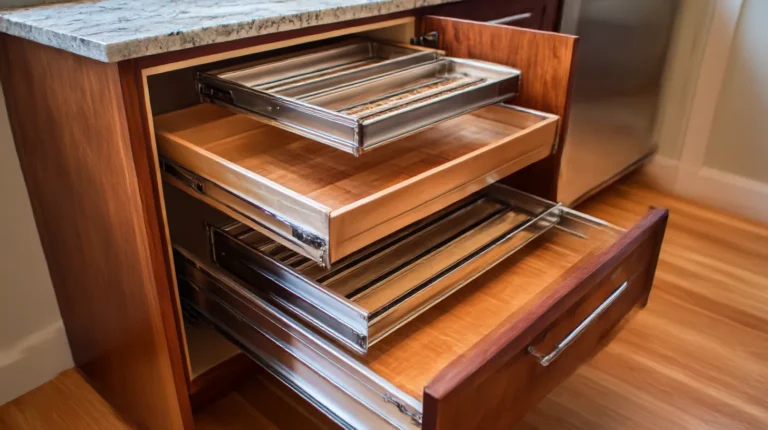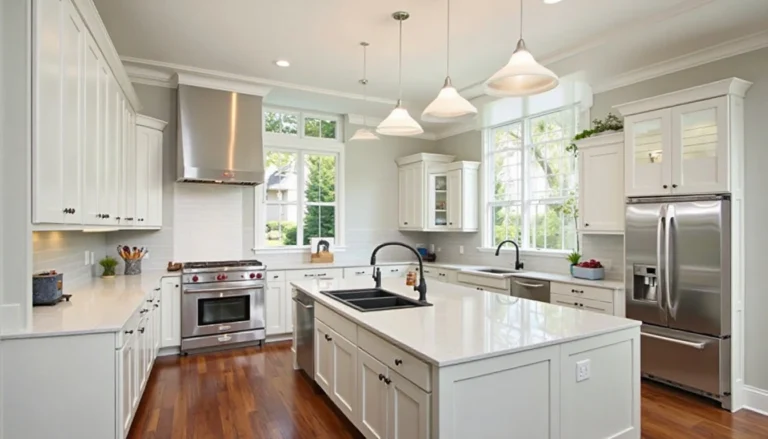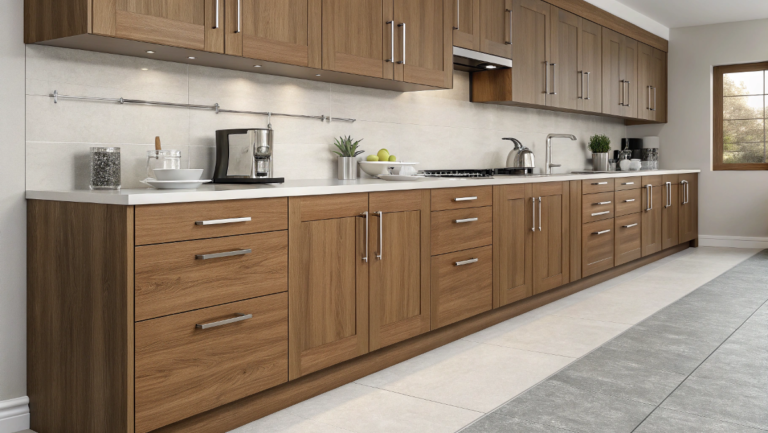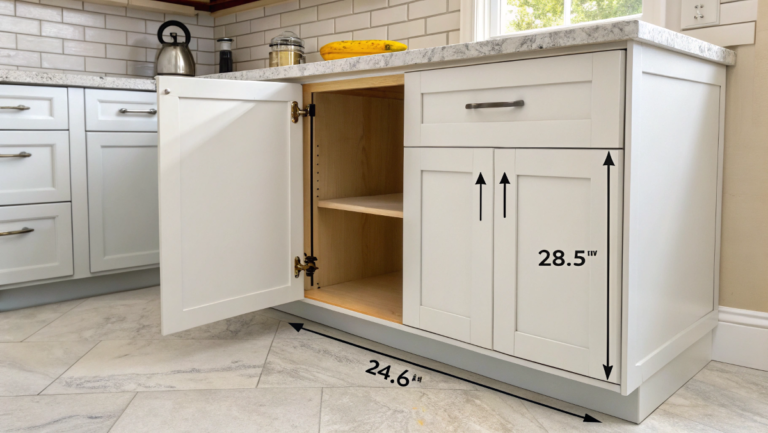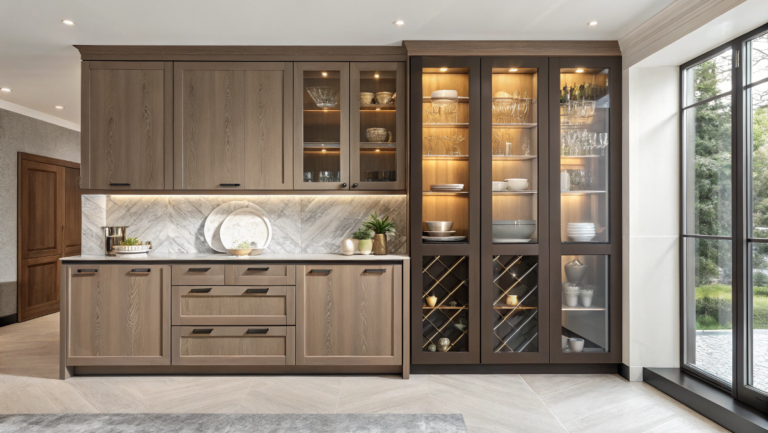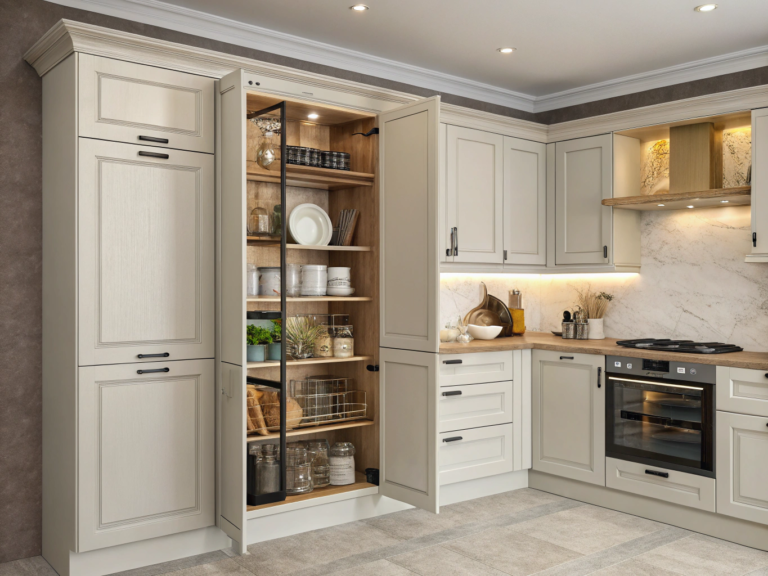best types of kitchen cabinets for my home
Funny how a kitchen can sneak up on you. Mine did, anyway. One minute I was wiping down a sticky drawer in my grandmother’s old house, and the next I was neck-deep in a rabbit hole of types of kitchen cabinets. I didn’t mean to become someone who knew the difference between base and wall units, or cared about them. But here we are.
What I realized, kind of slowly, is that cabinets do more than hold mugs and cereal boxes. They shape how a kitchen works. They define movement, mood, and even memory.
This guide isn’t just a list. It’s what I wish I had before trying to figure out why that corner cabinet made me feel like I was playing Tetris every morning. If you’re wondering what cabinet types are out there and which ones make sense for your space, you’ll find clarity here. Or at least fewer headaches.
Kitchen Cabinets 101. Why They’re More Than Just Storage,
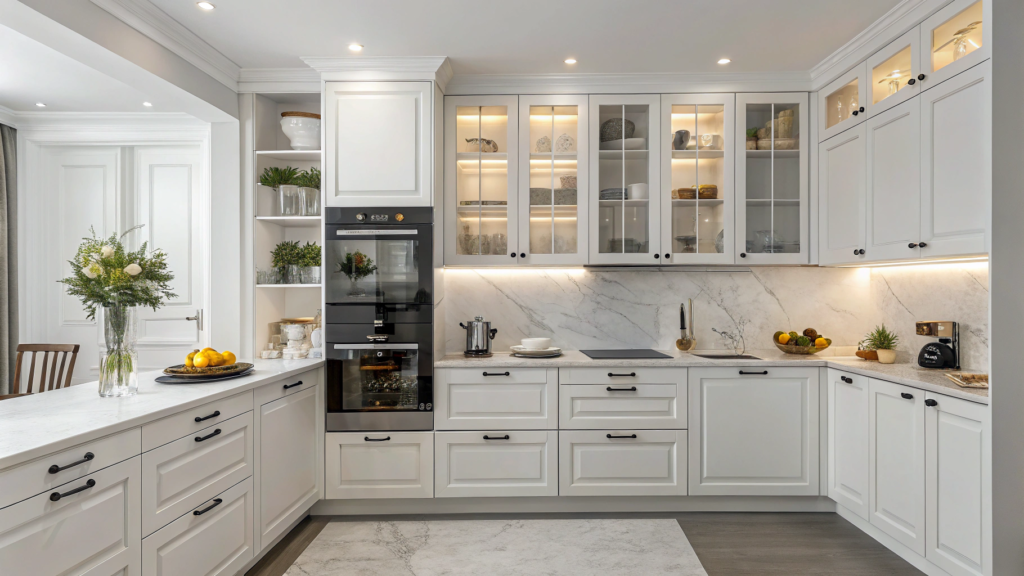
Before I ever cared about soft-close hinges or corner pull-outs, cabinets were just… there. Boxes on the wall. But once I started working on my kitchen, I realized cabinets do a lot more than store coffee mugs. They set the rhythm of the room.
Walk into any kitchen, and you’ll notice it, even if you don’t realize what you’re seeing. The space feels open or tight, practical or awkward, based almost entirely on where those cabinets sit and what type they are.
Let’s start with the basics, but not in the textbook way.
The Three Foundational Cabinet Types
-
Base Cabinets: These are your ground-level workhorses, the ones you lean on while chopping veggies or digging for your last clean skillet. They hold up your counters, define your layout, and honestly, make or break your workflow.
-
Wall Cabinets: Mounted above, these carry your daily dishes or that one mug you always reach for. But here’s something folks rarely talk about: height. If your wall cabinets are too high or too shallow, they’ll frustrate you every day.
-
Tall Cabinets: Often called pantry units, these stretch from floor to ceiling and are perfect for stashing bulk groceries, appliances, or even cleaning supplies. I installed one next to my fridge, and it became my kitchen’s walk-in closet.
Cabinets as Layout Anchors
Cabinets decide where everything else lives. Stove, sink, fridge, they all orbit around cabinet choices. And yes, a bad decision here will mess with your entire kitchen flow. (Been there. Regretted that.)
Even something as simple as whether you include a corner cabinet or avoid it can change how you use your space.
Do all kitchens need every cabinet type?
Not at all. Some of the most functional kitchens I’ve seen ditch upper cabinets for open shelving. Others skip tall cabinets to keep things airy. Think about how you cook and store things, not just what the layout guide says. Build for how you live, not how it “should” look.
Base vs. Wall vs. Pantry Cabinets: What’s the Difference (and Which Do You Need)?
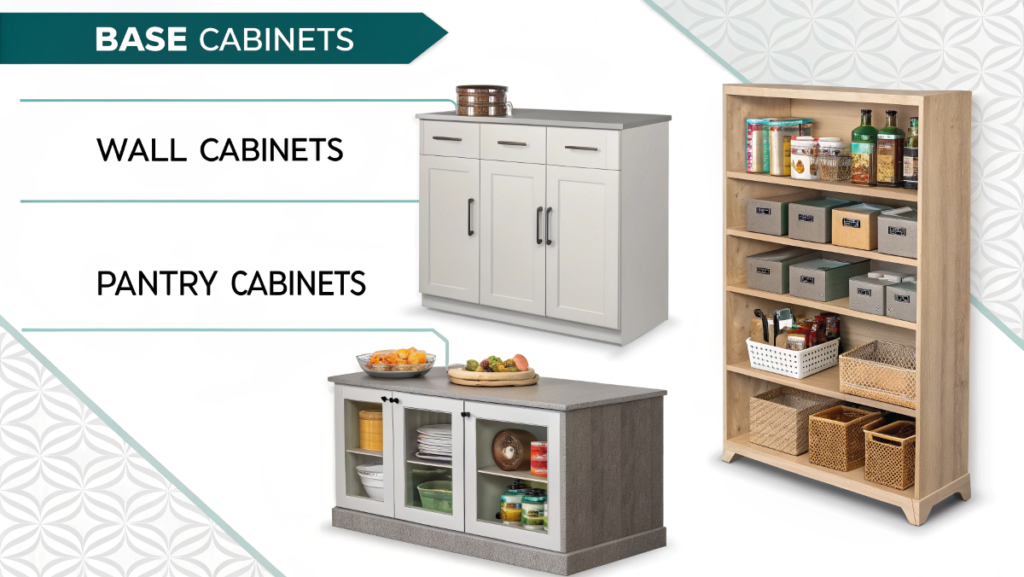
If you’re anything like me in my early remodel days, all cabinets kind of blur together. But once you break them down, base, wall, and tall pantry- they start to tell a very different story about how your kitchen functions.
Each one plays a specific role. Think of them like parts of a team: some do the heavy lifting, some float above the action, and others hold everything together behind the scenes.
Base Cabinets: The Backbone of Every Kitchen
These sit directly on the floor, usually topped by countertops, and carry the bulk of your everyday kitchen life. You’ll find drawers here, maybe your sink, and a whole lot of clutter if you’re not careful (guilty).
They’re usually around 24 inches deep and 34.5 inches high without the counter. But here’s something most guides won’t say: if your flooring isn’t level (like in older homes), installing these can be a journey. Shims become your best friend.
Wall Cabinets: Lifting the Load (Literally)
Wall cabinets mount to the wall and sit above your counters. They’re great for storing lighter items, plates, glasses, spices, and they visually frame your cooking area.
They’re shallower than base units (usually 12 inches deep), which is a blessing for headspace but a curse if you overstuff them. Tip from my chaos: install them at a height that works for you, not just what some manual says.
Tall Pantry Cabinets: Vertical Power Players
These pantry cabinets stretch from the floor to the ceiling and can store everything—food, cleaning supplies, even that rice cooker you swore you’d use more.
They’re usually 84 to 96 inches tall, and while they can feel like overkill in smaller kitchens, they’re instrumental when you need to hide a lot in a little space. If you’ve ever wished for a “closet, but make it kitchen,” this is it.
Can I mix cabinet types or skip one entirely?
Absolutely. No rulebook says you have to use all three. Some small kitchens go without wall cabinets entirely to feel more open. Others use two base cabinets and call it a day. Build around how you move and what you store—not a layout diagram in a catalog.
Specialty Cabinets You Didn’t Know You Needed (Until You Couldn’t Live Without Them)
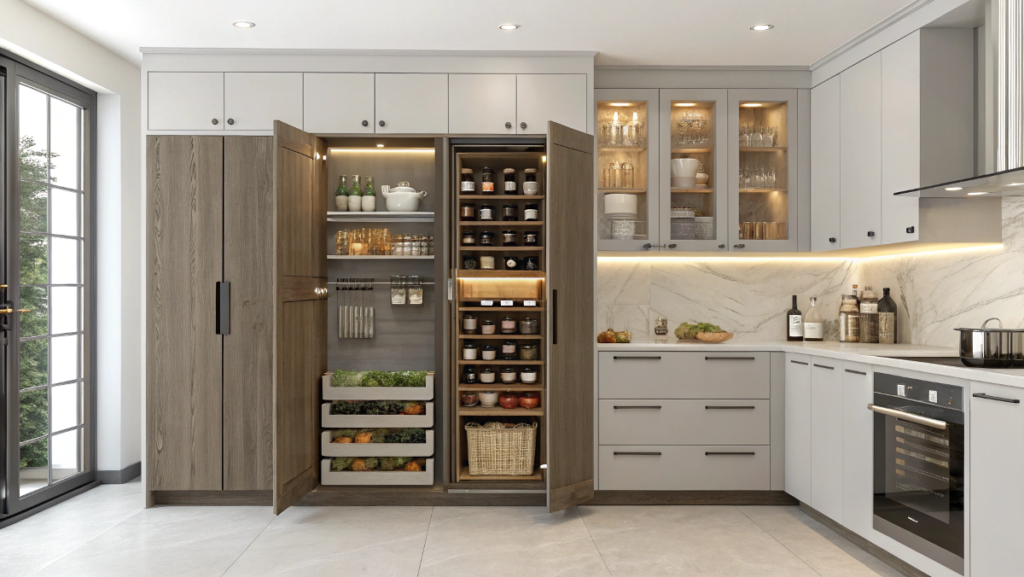
I didn’t go into my kitchen makeover thinking, “You know what I need? A toe-kick drawer.” I didn’t even know that was a thing. But one afternoon, while knee-deep in layout sketches and muttering at my measuring tape, I realized my kitchen had weird, wasted pockets of space, and I needed smarter solutions.
That’s where specialty cabinets come in. They’re the quiet MVPs of good design, not flashy, not always obvious, but once you live with them, it’s hard to imagine going back.
Real-Life Upgrades That Quietly Change Everything
-
Lazy Susan (Rotating Corner Shelf)
I used to ignore that deep corner cabinet because I couldn’t reach half of what was in it. Then came the spinning shelf. Now? It’s my go-to for mixing bowls and awkward-sized gadgets. It’s a little bit magic. -
Pull-Out Pantry
Narrow but tall, and somehow it fits more than my old broom closet. It slides out smoothly, no digging required. Plus, you can see everything at once, which means fewer forgotten cans and way less waste. -
Appliance Garage
It hides the clutter, but in a grown-up, intentional way. My toaster used to live out full-time like it paid rent. Now it tucks away neatly, and my counter finally looks like I meant for it to be clear. -
Vertical Dividers
If you’ve ever had a stack of baking sheets fall on your foot, you know. These slim compartments are for those flat-but-annoying things you never know where to put. -
Toe-Kick Drawers
They live down in that little gap under your base cabinets. And they’re perfect for storing stuff you use once a year but still need, like holiday platters or backup oven mittens.
Why Bother With These Extras?
Not everyone needs them. But if you’ve got tight corners, limited cabinets, or just a brain that craves tidy solutions, they’re worth a look. I added just two in my kitchen redo, and I feel like I leveled up without spending a fortune.
Are specialty cabinets a must for small kitchens?
Not a must, but often a smart move. If your space is compact, one or two clever upgrades, like a pull-out or a toe-kick drawer, can give you the functionality of a much larger kitchen. It’s less about luxury and more about a layout that works for your life.
Kitchen Cabinet Styles, Not Just Looks, But a Whole Vibe
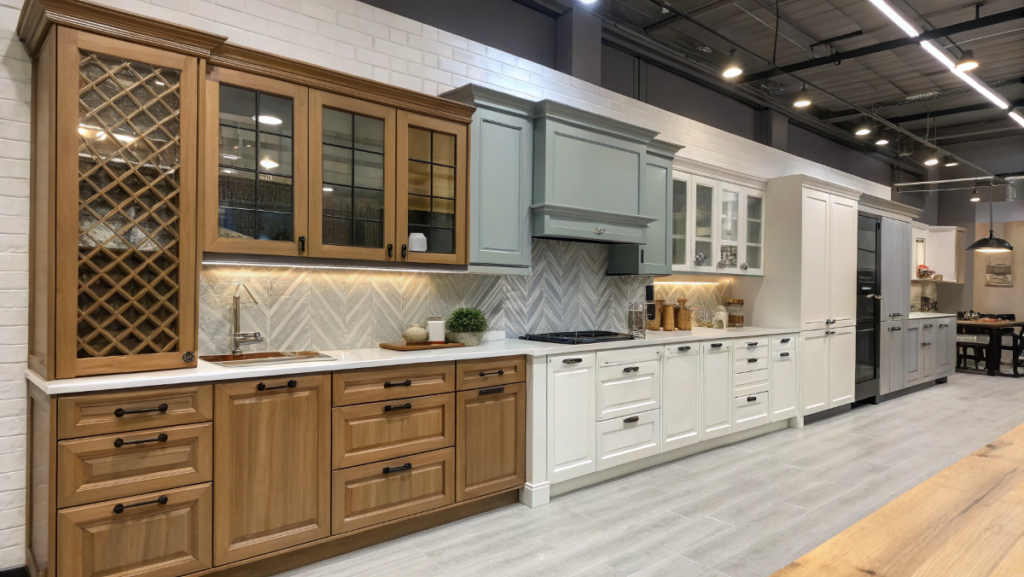
Before I knew what shaker or slab meant, I used to describe cabinet styles as “the flat ones” or “the ones with lines.” I’d point at Pinterest photos and hope for the best. But the deeper I got into planning my kitchen, the more I realized: cabinet style isn’t just decoration. It’s the tone of the entire room.
You know how some kitchens feel soft and warm the moment you walk in, while others feel crisp and deliberate? That’s cabinet style doing its job.
The Styles That Matter (and What They Say About You)
-
Shaker
The go-to for so many remodels, and for good reason. It’s got those squared-off edges and a recessed panel that feels tidy without being fussy. I chose a shaker for my kitchen because it didn’t scream for attention, but still made everything feel anchored. -
Flat-Front (Slab)
These are ultra-smooth, no embellishments, and kind of moody in the best way. They make a small kitchen look bigger and cleaner, but they’re also a magnet for fingerprints, especially if you’ve got shiny finishes and sticky fingers in the house. I nearly chose these. Nearly. -
Raised Panel
These feel more ornate, kind of the kitchen version of a tailored suit. They show dimension, structure, and just a hint of drama. I think of them in homes where someone still uses the good china and lights a candle at dinner just because. -
Inset Doors
These sit flush with the frame, very precise, very polished. They remind me of custom-built furniture you’d find in an old New England home. Gorgeous? Yes. Forgiving of uneven walls or rushed installations? Not so much. -
Textured Options (like Beadboard)
These have ridges, grooves, or visible lines that add character. Cottagecore, farmhouse, vintage charm, you know the vibe. I love looking at them in other people’s kitchens. But me? I flinch at the thought of wiping crumbs out of crevices.
How to Choose When You’re Not a Designer
Ask yourself what kind of energy you want in the space. Structured and minimal? Go slab. Warm and flexible? Maybe a shaker. Quirky with charm? Beadboard or something with detail.
There’s no award for picking the trendiest look. Choose the one that matches your morning routine, your clutter tolerance, and your favorite coffee mug.
What if I like more than one style?
You’re not alone. Mixes can work beautifully, like slab uppers with shaker lowers, but keep one thing consistent, whether it’s color, hardware, or finish. Otherwise, you risk entering “Pinterest chaos” territory where nothing feels grounded.
Frame vs. Frameless Cabinets: Why This One Detail Changes Everything
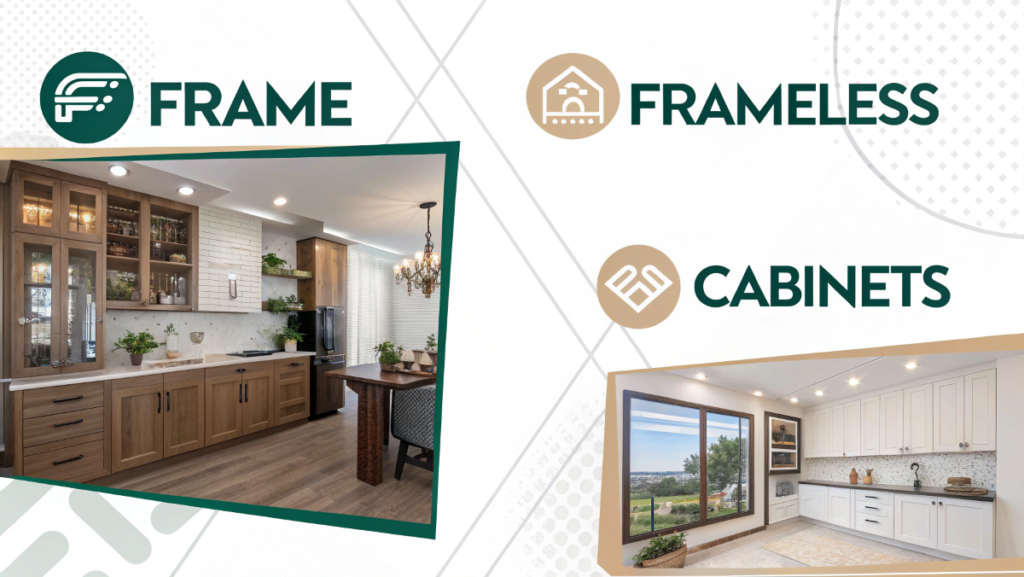
I didn’t even know this was a thing until I found myself staring at two nearly identical cabinet doors with very different price tags. One had a frame. The other didn’t. And apparently, that tiny difference changes everything, from how your doors fit to how much storage space you get, to how your kitchen looks overall.
If you’ve ever heard “frameless” and thought it sounded like a design trend or just a sleeker look, you’re not wrong, but there’s more to it.
What’s the Difference?
-
Framed Cabinets
These have a face frame, essentially a 1.5-inch border that outlines the front. It gives the box more structure and lets you use a variety of door styles (like inset or overlay). It’s common in traditional kitchens, and if you grew up in the U.S., chances are you’ve lived with framed cabinets your whole life.-
Pros: Stronger construction, slightly easier to install on uneven walls, fits lots of styles
-
Cons: Slightly less interior space, visible frame may not suit modern designs
-
-
Frameless Cabinets
Also known as “European style,” these ditch the face frame entirely. Doors attach directly to the box. The result? A clean, flush exterior and a little more usable space inside.-
Pros: Sleek look, more storage room, seamless modern vibe
-
Cons: Less forgiving if your walls aren’t straight, hinges require precision
-
My Experience? I’ve Tried Both.
When I updated my grandma’s kitchen, we stuck with framed. They felt familiar, solid, and worked well with the slightly wavy walls. But in a newer build I helped plan for a friend, we went frameless, and wow. Everything looked crisp, like the cabinets had been poured into place. Neither is “better,” but each suits a different kind of kitchen (and cook).
How do I choose between framed and frameless cabinets?
It depends on your priorities. If you want traditional charm and flexibility, framed might be your match. If you’re going for sleek minimalism or need every inch of space, frameless could be the better bet. Also, consider your home’s age; frameless tends to need straighter, more even walls for a clean install.
Cabinet Materials & Finishes, What Your Cabinets Are Really Made Of (and Why It Matters)
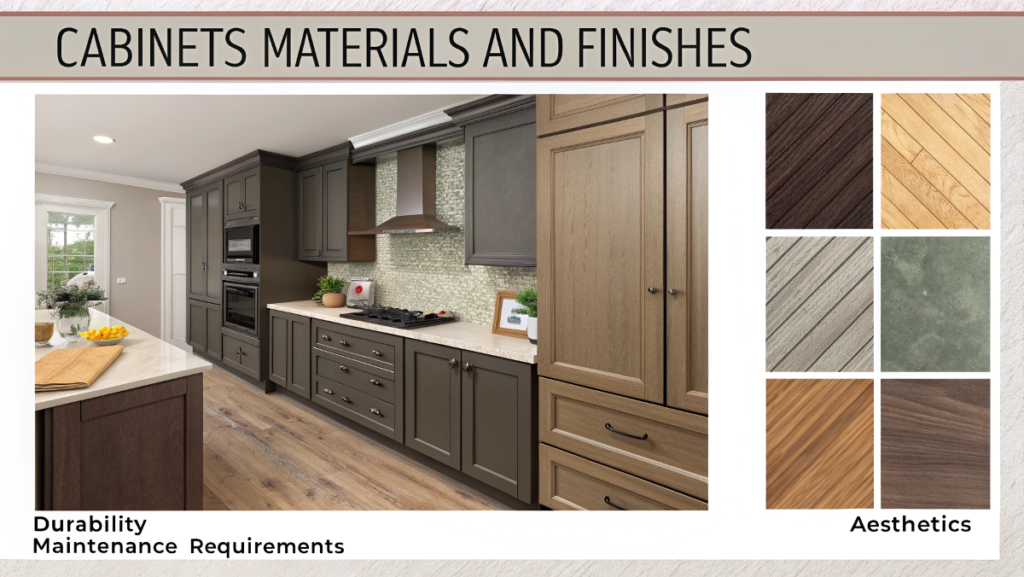
When I first started shopping for cabinets, I thought I was choosing a look. Turns out, I was choosing how my kitchen would feel, function, and, let’s be honest, how many coffee spills it could survive.
Because of cabinet materials? They’re more than wood or “not wood.” They change how a door sounds when it closes, how it handles humidity, whether it forgives a dropped pan or holds a grudge.
Let me walk you through what I learned, some of it the hard way.
Materials That Live Inside Your Cabinets (And Sometimes Inside Your Head)
-
Wood (Real-deal solid wood)
Think maple, oak, cherry, each with its own mood. It dents, it expands, it has opinions. But it also ages beautifully and smells like something worth keeping. I used it on upper cabinets once and still catch myself running my hand across the grain like it’s a pet. -
MDF (Medium-Density Fiberboard)
Smooth, stable, and almost too perfect. It doesn’t warp the way solid wood can, which is a gift in high-humidity areas. But don’t let water near it. Trust me. One leak under my sink, and I was watching my cabinet base puff up like a sad balloon. -
Plywood
Built from cross-layered wood sheets, it’s tough and surprisingly light. Most cabinet boxes are made of this, and when they’re not, I ask why. It holds screws better than MDF and handles wear without being dramatic about it. -
Thermofoil & Laminates
These are finishes, not materials, but they matter. Thermofoil wraps like a skin over MDF, smooth, uniform, great for modern looks. Until it gets too hot. I scorched one next to the toaster oven once. Lesson learned. Laminates are layered on, too, but they hold up better to heat and mess… just don’t expect them to age with grace.
Finish Isn’t Just a Coat of Paint, It’s a Mood
-
Paint
Looks clean and modern, especially on smooth surfaces like MDF. Downside? Chips. I carry a tiny bottle of touch-up paint like it’s lip balm. -
Stain
Let’s be wood. It doesn’t hide imperfections, it highlights them. Which, depending on your style, is either honest or annoying. -
Matte vs. Gloss
Matte is forgiving. Gloss is bold but brutally honest about fingerprints and smudges. I’ve tried both. One looked better in photos; the other looked better when I lived with it.
Is it worth paying more for better cabinet material?
Usually, yes, if your kitchen sees daily action. A slightly stronger box or a better finish won’t make your meals taste better, but it’ll save you stress two years down the line when the door still hangs straight and the corners haven’t peeled. If budget is tight, prioritize good boxes over flashy finishes. You can repaint, but you can’t rebuild from scratch without regret.
Smart Storage Tricks That Make Small Kitchens Feel Bigger (and Big Kitchens Feel Smarter)
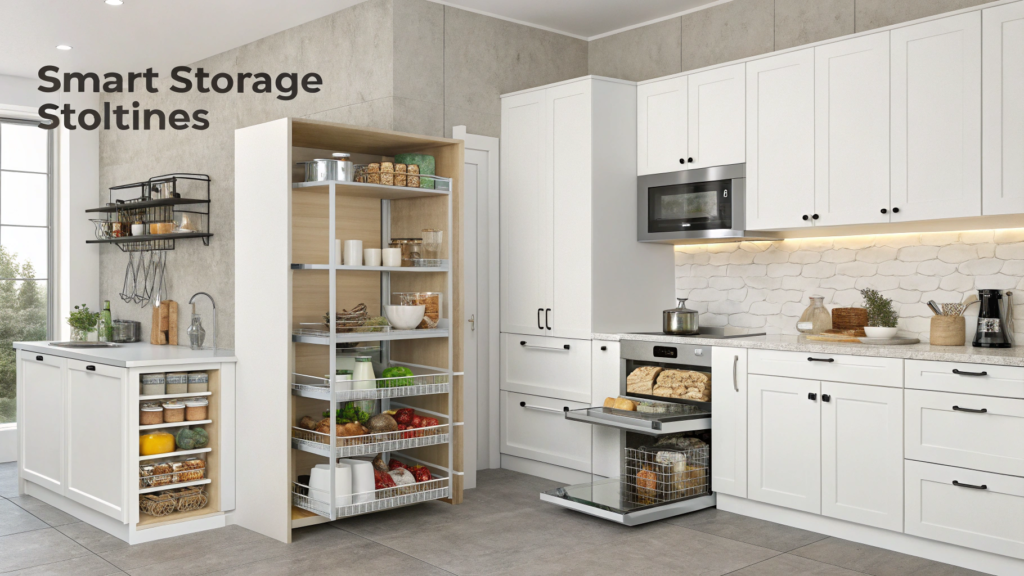
Let’s be honest, most kitchens, no matter the size, end up with at least one drawer that becomes a junk trap and one cabinet where pans go to disappear. Mine had three. That’s where storage strategy comes in, not the kind with trendy baskets and labels, but the kind built into your cabinets.
I didn’t think much about storage tricks until I realized I was rearranging the same three baking sheets every week just to get to my cutting board. It’s not about having more space, it’s about making your space work harder.
Clever Cabinet Features That Actually Do Something
-
Pull-Out Shelves
These cabinet pull-out shelves slide out like drawers inside your base cabinets. Perfect for pots, pans, or that blender you swear you’ll use more. I added one under my sink and still pat myself on the back every time I grab dish soap without bending over sideways.. -
Drawer Organizers
Not the plastic kind from the store, but the built-in slots that separate utensils, knives, even spices. It’s like opening a drawer and hearing a small “ahhh.” -
Toe-Kick Storage
That awkward little gap at the bottom of your base cabinets? It can be a drawer. I use mine for extra trays and backup oven mittens. I forget it exists until Thanksgiving. -
Trash & Recycling Pull-Outs
Hidden inside a cabinet, they keep the kitchen cleaner and quieter. I fought for this in my layout, and I’d fight for it again. -
Vertical Tray Dividers
Game-changer for baking sheets, cutting boards, or those rogue lids you never know where to put. -
Corner Pull-Outs or LeMans Units
Fancy names, practical magic. They turn deep corner cabinets into smooth-glide shelves that don’t swallow your stuff.
What’s the best storage upgrade for a small kitchen?
Start with one pull-out shelf and one vertical divider. These two alone can transform how you access your daily essentials—and prevent that dreaded “cabinet avalanche” when something shifts just right (or wrong). From there, add only what solves your daily frustrations.
Stock, Semi-Custom, or Custom Cabinets? Here’s What They Really Mean (and When Each One Makes Sense)
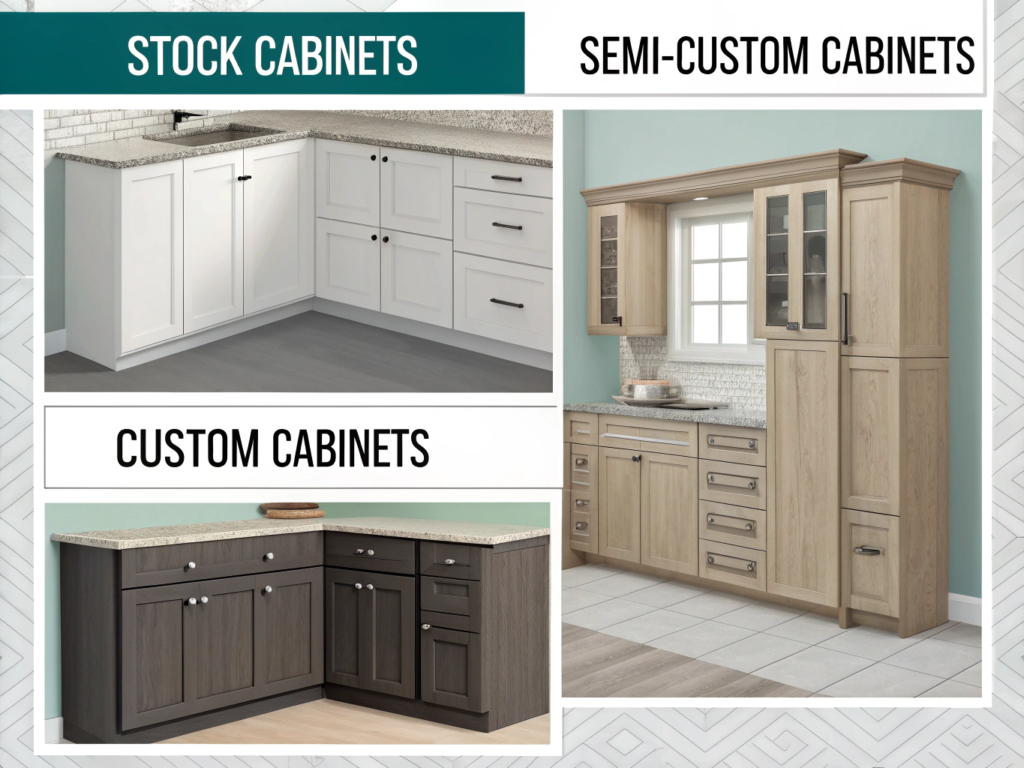
I remember staring at three price tiers in a cabinet showroom, trying to look like I understood the difference. I didn’t. And if you’re in the same boat, don’t worry, you’re not alone.
The truth? Those little labels, stock, semi-custom, custom, have less to do with quality than you’d think, and more to do with flexibility, timeline, and how picky you’re allowed to be.
Let’s break it down like a human, not a catalog.
What Each Type Actually Is
-
Stock Cabinets
Pre-built, pre-sized, and ready to go. Think big box stores or quick kitchen refreshes. Limited options, but affordable and fast. I used stock in a rental unit once, and it held up surprisingly well.-
Best if: You’re on a budget or need a quick install
-
Watch out for: Fit issues in weird layouts, fewer finish/style combos
-
-
Semi-Custom Cabinets
The middle ground. You choose from a set of styles and sizes, but can tweak dimensions, finishes, and features. This is what I used in my main kitchen remodel, and it hit the sweet spot between price and personalization.-
Best if: You want design flexibility without going full custom
-
Watch out for: Extended lead times and upcharges for “minor” changes
-
-
Custom Cabinets
Made from scratch to your exact specs. You pick everything: dimensions, materials, hardware, finish, even odd-shaped spaces or built-ins are fair game.-
Best if: You’ve got a tricky layout or specific vision (and the budget to back it)
-
Watch out for: Costs climbing fast, long wait times, and the pressure of having too many choices
-
My Take? Fit the Cabinets to the Life You Actually Live
If you rarely cook but love a good dinner party, invest in the visual finishes. If you cook every night, focus on storage and durability. I’ve seen stunning custom kitchens that didn’t function well, and modest semi-custom layouts that worked like a dream. It’s not just what you buy. It’s how you use it.
Can I mix stock and custom pieces in one kitchen?
Absolutely. You can use stock cabinets for the bulk of your layout and go custom on just a few pieces, like a tall pantry or island. It’s a smart way to stretch a budget while still getting those “wow” moments.
Cabinet Costs, What You’ll Spend (And Where You Can Save Without Regret)
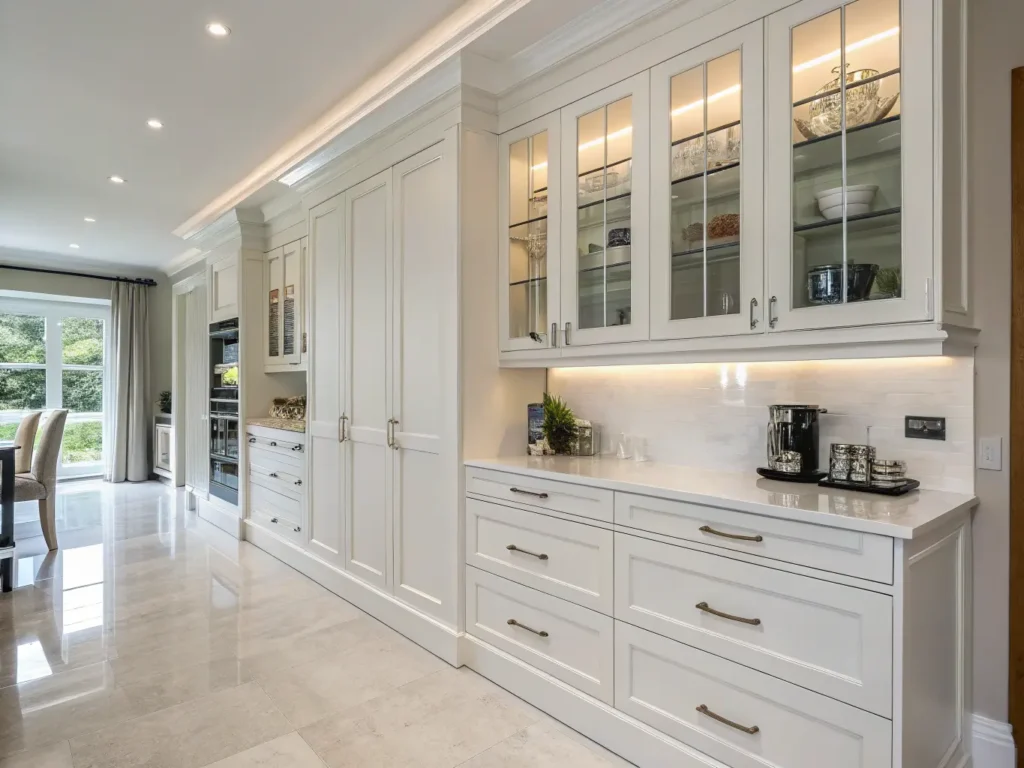
Let’s skip the vague “it depends” advice. Yes, cabinet pricing varies wildly, but most people don’t want a range from $2,000 to $50,000; they want to know what’s realistic for their kitchen and goals.
So here’s a grounded, honest look at what different types of cabinets typically cost, and where you might be able to cut back without sabotaging your dream.
Average Cabinet Price Ranges (Per Linear Foot)
-
Stock Cabinets: $60–$200
-
Budget-friendly, off-the-shelf. Ideal for rentals, flips, or when you need to get it done fast. Quality varies a ton, so touch before you buy.
-
-
Semi-Custom Cabinets: $150–$650
-
Offers flexibility in design and dimensions, and the price reflects that. You’ll pay more for upgraded finishes, soft-close hinges, or non-standard sizes.
-
-
Custom Cabinets: $500–$1,200+
-
Designed from scratch. Perfect fit, unlimited choices, and a hefty bill. Can easily hit $20k+ for a full kitchen, especially with high-end wood or unique layouts.
-
What Affects the Final Cost (That No One Tells You Upfront)
-
Material Choice: MDF and laminate will cost less than plywood or solid hardwood
-
Door Style: Slab is cheaper to manufacture than detailed panel designs
-
Finish: Painted cabinets often cost more than stained (especially if you go with darker shades)
-
Hardware: Handles, pulls, hinges, these add up fast, especially soft-close features
-
Layout Complexity: Corners, islands, tall units, or angled walls? Expect custom pricing
Maya’s Budget Tip
Don’t overspend on upper cabinets if you’re rarely using them. I went semi-custom on my base cabinets (because I’m in and out of those constantly), but saved by using open shelving up top. Not only was it cheaper, but it also opened up the whole room visually.
Is it cheaper to refinish old cabinets than to replace them?
Most of the time, yes. If the cabinet boxes are sturdy, a good sanding, painting, or refacing can dramatically refresh the space at a fraction of the cost. Just make sure the bones are solid; paint won’t fix structural sagging.
Kitchen Cabinet FAQs, Because You’re Not the Only One Wondering
By the time I was knee-deep in planning, I had a whole note in my phone called “Weird Cabinet Questions I’m Too Embarrassed to Ask.” Here are a few I wish someone had answered plainly, without the jargon or judgment.
How many types of kitchen cabinets are there?
Most kitchens are built around five cabinet types: base, wall, pantry (or tall), corner, and specialty. That last one, specialty, is where the real magic happens. Pull-outs, tray dividers, toe-kick drawers… the kind of features you don’t know you need until you can’t live without them.
What do stock, semi-custom, and custom cabinets mean?
-
Stock cabinets are pre-made in standard sizes, fast and affordable, but not super flexible.
-
Semi-custom lets you tweak dimensions and finishes, think of it as a tailored off-the-rack option.
-
Custom is a total design free-for-all: you pick everything, and the price reflects it.
I went semi-custom for my remodel, and it gave me just enough wiggle room to make things feel intentional without draining my budget.
What’s the difference between cabinet style and cabinet type?
Style is about the look: shaker, slab, raised panel.
Type is about the function, base, wall, pantry, etc.
It’s like the difference between wearing jeans vs. joggers (type)… and whether they’re classic cut or ultra high-rise (style). Both matter, just for different reasons.
Which cabinet style is most popular?
Shaker is still the champ. Clean lines, understated edges, it plays nicely with nearly every kitchen theme. I picked it because it didn’t try too hard, and honestly, it still makes my kitchen feel grounded.
Are there any cabinet trends that feel tired or dated?
Overly ornate finishes and high-gloss cherry wood are starting to fade. But trends shift. If you’re drawn to something because it feels right in your space, forget what’s “in” and go with what you love. A little conviction makes anything timeless.
What kind of cabinet build holds up best over time?
From what I’ve seen (and lived with), plywood boxes paired with hardwood doors stand the test of time. It’s less about the label and more about craftsmanship. Hinges that don’t sag. Doors that don’t swell. That’s where longevity lives.
Are upper cabinets necessary in every kitchen?
Nope. I went without uppers on one wall and never missed them. But if you need hidden storage or live with someone who can’t stand visual clutter (hi, Dad), upper cabinets can still earn their keep.
Can I mix styles or colors without it looking weird?
You totally can, if you’re deliberate about it. I’ve seen slab uppers with shaker lowers look stunning. The key is cohesion: carry the same finish, use matching hardware, or repeat a tone. Done right, it looks layered, not accidental.
So, What Kind of Cabinets Will You Choose?
If you made it this far, then you’re not just looking for cabinet types, you’re looking for clarity. And maybe a little confidence, too.
Because here’s what I’ve learned: kitchen cabinets aren’t just boxes. Their rhythm. They’re comfort. They’re the quiet structure behind morning routines and late-night snacks. Choosing them isn’t about getting it “perfect.” It’s about creating a space that fits the way you move, cook, live, and gather.
Whether you lean minimalist with flat-fronts or love the charm of a soft-close drawer tucked into a shaker frame, your choices will shape more than just a kitchen; they’ll shape the way you feel in it.
And that’s what matters most.
Your next step?
Take what stood out to you, maybe it was a cabinet style, a smart storage fix, or just the idea that you can mix things and still make it feel intentional, and sketch it out. Bookmark the ideas. Pin the ones that feel like home. And when you’re ready, build the kitchen that works for your life, not just the showroom.
Want help making it happen?
Drop a comment below or reach out, I’d love to hear what your dream kitchen looks like.
Useful Resources
- Browse ready-made types of kitchen cabinets on Amazon
- Compare types of kitchen cabinet styles on Lowe’s

